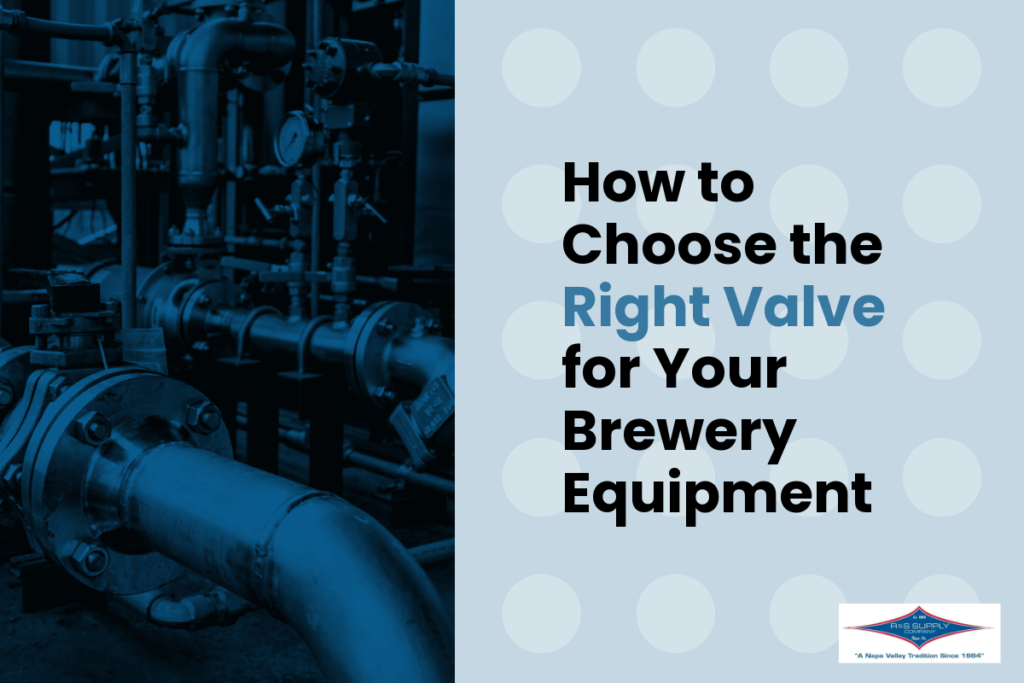Selecting the right valve for your brewery equipment is critical to ensuring the efficiency, cleanliness, and safety of your brewing process. With so many types of valves available on the market, each with distinct characteristics, knowing which one suits your brewing setup can make all the difference. This guide will walk you through the key considerations to help you choose the best valve for your brewery equipment.
1. Understand the Role of Valves in Brewing
Valves are essential components in any brewery, as they control the flow of liquids such as water, wort, and beer throughout the brewing process. Proper valve selection impacts the efficiency of your system, the cleanliness of your operation, and the quality of your final product. From controlling flow rates to maintaining hygiene, valves play a pivotal role in streamlining operations and preventing contamination.

2. Types of Valves for Brewery Applications
Here are the most common types of valves used in breweries:
Butterfly Valves:
Lightweight and easy to operate, butterfly valves are often used in brewing due to their simple design and cost-effectiveness. These valves work well for regulating flow but are best suited for low-pressure applications.
Ball Valves:
Known for their durability and excellent sealing, ball valves are used to completely shut off the flow or regulate it with precision. They are ideal for high-pressure applications and are widely used in breweries for both wort transfer and cleaning processes.
Diaphragm Valves:
Designed for sanitary environments, diaphragm valves are a great choice for breweries focused on maintaining a high level of cleanliness. These valves are ideal for controlling flow in applications where contamination must be avoided, as they feature no internal cavities where debris can accumulate.
Divert Valves:
Divert valves allow for switching the flow direction of liquids, which is important in multi-step brewing processes. These are useful in breweries with complex systems that require a flexible valve for diverting liquids without manual intervention.
Check Valves:
Check valves are essential in preventing backflow, which can contaminate your brew and cause system issues. They only allow liquid to flow in one direction, ensuring a smooth and safe brewing process.
3. Valve Materials: Stainless Steel is Key
For brewery equipment, stainless steel is the material of choice for most valves. Stainless steel valves, particularly those made from AISI 316L, are highly resistant to corrosion and can handle the heat, pressure, and chemicals involved in brewing. They also meet sanitary standards for food and beverage production, making them ideal for brewing applications.
4. Hygienic Design
When choosing a valve for your brewery, hygiene should be a top priority. Valves used in breweries should meet EHEDG (European Hygienic Engineering & Design Group) or 3A sanitary standards to ensure they can be easily cleaned and sterilized. Valves with smooth internal surfaces and minimal dead space reduce the risk of contamination and bacterial growth, safeguarding the quality of your beer.
5. Consider the Type of Connection
The way a valve connects to your system matters just as much as the valve itself. Brewery equipment typically requires one of the following connection types:
- Threaded: Easy to install and remove, threaded valves are ideal for systems where frequent disassembly is required. However, they can be prone to leaks if not properly sealed.
- Butt Weld: These valves are welded directly to the pipeline, creating a leak-free and durable connection. Butt weld valves are often used in breweries for their strength and sanitary qualities, as they are less likely to harbor contaminants.
- Tri-Clamp: A popular choice for breweries, tri-clamp connections are easy to disassemble for cleaning, making them an excellent option for systems that need regular maintenance.
6. Flow Control and Automation
Many modern breweries benefit from automation to optimize efficiency and control. If you want to automate your brewing process, selecting valves that are compatible with actuators is crucial. Automated ball valves or butterfly valves can be easily controlled remotely, allowing for more precise management of flow rates, temperature, and pressure throughout the brewing process.
7. Pressure and Temperature Considerations
The pressure and temperature levels in your brewing system should guide your valve choice. For example, ball valves are more suited to high-pressure situations, while butterfly valves work well in low-pressure systems. Always check the pressure and temperature ratings of a valve to ensure it can withstand the conditions in your brewery without degrading over time.
8. Valve Size and Flow Rate
The size of the valve directly impacts the flow rate and system efficiency. A valve that is too small may restrict flow and slow down your brewing process, while an oversized valve could result in poor control. It’s important to select a valve size that matches your piping system and flow requirements.

Choose the Right Valve for Optimal Brewing Efficiency
Selecting the right valve for your brewery equipment is key to optimizing performance and ensuring product quality. Consider the type of valve, material, connection, and compatibility with your system to find the perfect fit. Whether you prioritize sanitation, flow control, or automation, choosing the right valve can elevate your brewing process and lead to better results.
If you’re ready to improve the efficiency of your brewery, explore our wide range of valves designed specifically for brewing applications. The right valve can make all the difference!

